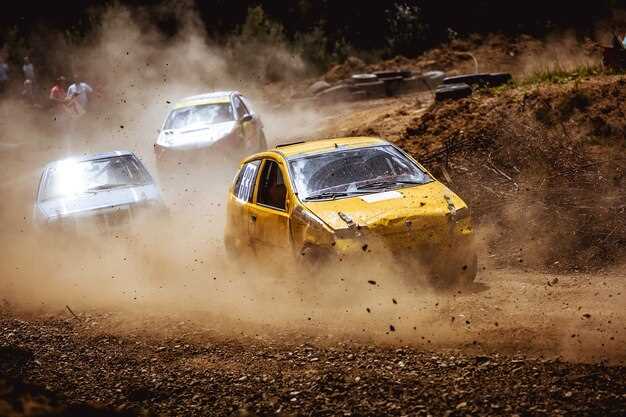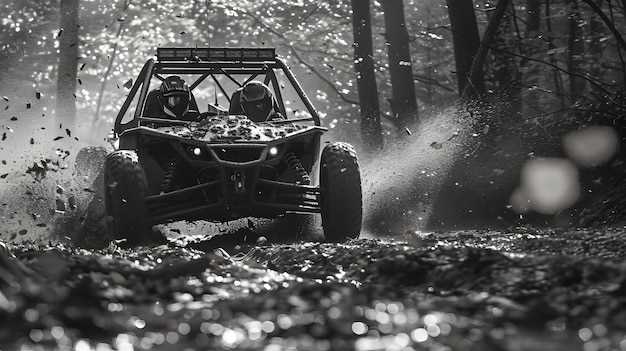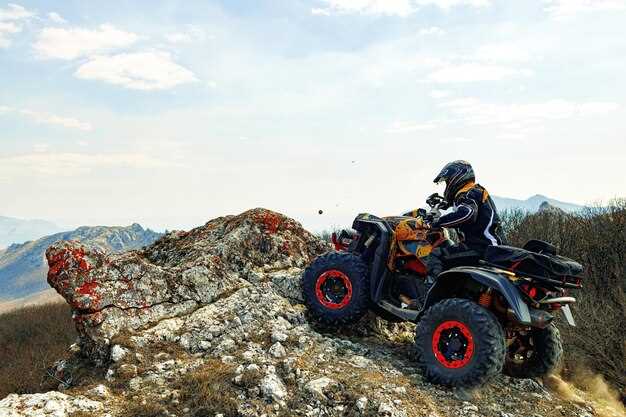
In the world of off-road motorsports, two distinct disciplines stand out: rock crawling and high-speed off-road racing. Both genres present unique challenges and require specific techniques for success, yet they cater to different types of adrenaline seekers. While rock crawling emphasizes the technical skills necessary to navigate treacherous terrains at a slow pace, high-speed racing demands an entirely different approach, focusing on speed and agility across vast open landscapes like the Baja desert.
Rock crawling is all about precision and patience. Drivers must skillfully maneuver their vehicles over rugged rocks and steep inclines, where brute force is not always the best solution. Each obstacle requires a careful strategy, often involving the use of specialized equipment and techniques that allow vehicles to ‘crawl’ over formidable obstacles. Understanding the terrain, vehicle dynamics, and tire selection are crucial elements that define a successful typical rock crawling session.
In contrast, high-speed off-road racing is synonymous with rapid acceleration and navigating through desert landscapes at breakneck speeds. Here, racers are required to master the art of driving on loose surfaces, while maintaining control and maximizing their vehicle’s performance. Techniques such as throttle control, suspension tuning, and navigating jumps become essential skills for completing a racecourse successfully. The adrenaline rush from racing through the Baja terrain at full throttle creates a different kind of excitement than the methodical pace of rock crawling.
Understanding Key Differences in Vehicle Setup

When it comes to off-road motorsport, the distinction between rock crawling and baja racing is significant, particularly in vehicle setup. Each discipline demands unique configurations and features that cater to their specific challenges.
Key Elements of Vehicle Setup for Rock Crawling
Rock crawling involves navigating over rugged terrains with steep inclines and large obstacles. Here are some essential components of a vehicle designed for this sport:
- Suspension: A flexible suspension system is crucial. Long-travel suspensions allow for better articulation, enabling the vehicle to navigate uneven surfaces.
- Low Crawl Ratio: Vehicles require a low gear ratio to provide high torque at low speeds, facilitating controlled crawls over obstacles.
- Tires: Large, grippy tires with deep treads enhance traction on rocky surfaces, providing stability and control.
- Skid Plates: Protective plates are essential to shield critical components from damage while crawling over rough terrain.
- Weight Distribution: A balanced weight distribution aids in improving traction and maneuverability on steep slopes.
Key Elements of Vehicle Setup for Baja Racing
Baja racing, on the other hand, focuses on speed across diverse terrains, including deserts and open dirt tracks. Here are important features of vehicles for this high-speed discipline:
- High-Focused Suspension: Vehicles require stiff, well-tuned suspension systems that can absorb jumps and bumps while maintaining speed.
- High Engine Output: Powerful engines facilitate quick acceleration, allowing drivers to maintain high speeds on flat terrains.
- Lightweight Design: Reducing overall weight enhances speed and agility. This can include using lightweight materials for the frame and body.
- Aerodynamic Features: Streamlined designs reduce drag, improving the vehicle’s performance at high speeds.
- Durable Tires: Tires designed for high-speed stability with a solid grip on varied surfaces ensure safety and control during the race.
In summary, the setup of vehicles in rock crawling and baja racing is intentionally tailored to meet the requirements of each sport. Understanding these key differences allows enthusiasts to optimize their vehicles for either crawling or racing, ensuring safety and performance in their respective environments.
Mastering Terrain Navigation for Rock Crawling

In the world of off-road racing, rock crawling presents unique challenges that require specialized techniques for effective terrain navigation. Unlike high-speed races across expansive baja landscapes, rock crawling demands precision, patience, and a deep understanding of the environment.
First and foremost, understanding the terrain is crucial. Drivers must assess the obstacles ahead, identifying potential hazards such as boulders, steep inclines, and loose rocks. This evaluation helps in planning a strategic route, minimizing the risk of getting stuck or damaging the vehicle during the crawl.
One effective technique for navigating tough terrain is utilizing the vehicle’s approach and departure angles. Mastering these angles allows drivers to tackle obstacles without the risk of bottoming out. Ensuring proper vehicle setup, including suspension and tire selection, can significantly enhance performance on rocky surfaces.
Moreover, maintaining momentum is essential in rock crawling. While slow and calculated movements are vital, carefully applying throttle can help navigate over obstacles effectively. Drivers should practice the art of throttle modulation, which involves balancing power and traction to maintain movement without losing control.
Another key factor in terrain navigation is tire placement. Observing where tires make contact with the ground can provide insight into the best path forward. Positioning tires strategically on larger rocks can help avoid potential pitfalls and ensure each wheel maintains traction, enhancing overall stability during the crawl.
Lastly, communication and teamwork can play a significant role, especially in organized rock crawling events. Spotters can aid drivers by providing guidance and insights on navigation, helping to avoid unseen dangers while determining the most efficient route through challenging landscapes.
In conclusion, mastering terrain navigation for rock crawling involves a blend of vehicle control, environmental awareness, and strategic planning. By honing these skills, drivers can not only enhance their performance but also elevate the overall experience of tackling off-road adventures.
Optimizing Speed and Control in Baja Racing
In Baja racing, the balance between speed and control is crucial for success. Unlike rock crawling, where precision is paramount to navigate obstacles, Baja racing demands quick reactions and adaptability to changing terrains, often at high speeds. To optimize performance, racers must consider various factors, including vehicle setup, driver skills, and terrain knowledge.
One of the key aspects of achieving optimum speed in Baja racing is the vehicle’s suspension system. A well-tuned suspension not only absorbs impact from rough terrain but also maintains traction on uneven surfaces. Different suspension setups can be used on vehicles to suit varying conditions, providing a balance between stability and agility.
Moreover, tire selection and pressure play a significant role in maximizing speed while ensuring control. Tires must provide sufficient grip on loose dirt and gravel, enabling drivers to maintain high velocities without sacrificing stability during sharp turns.
Another critical factor is understanding the race course. Familiarity with the terrain enables drivers to anticipate challenges, allowing them to execute strategic maneuvers that enhance speed and control without compromising safety. This awareness can transform a potentially challenging section of the track into an opportunity for gaining ground on competitors.
| Factor | Impact on Performance |
|---|---|
| Suspension Setup | Improves traction and stability on rough terrain |
| Tire Selection | Enhances grip and control during high-speed sections |
| Course Knowledge | Enables strategic driving and optimal speed handling |
| Driver Skill | Improves reaction time and precision in challenging scenarios |
Ultimately, mastering the dynamic between speed and control in Baja racing involves a combination of vehicle performance and driver expertise. By focusing on these key factors, racers can improve their chances of success, effectively navigating the demanding landscapes of Baja racing while optimizing their ability to race rather than crawl through the competition.
Techniques for Overcoming Obstacles in Rock Crawling
Rock crawling presents unique challenges that require specialized techniques to navigate obstacles effectively. Understanding these methods is crucial for any off-road enthusiast aiming to tackle rocky terrains successfully.
First and foremost, precise throttle control is essential. In rock crawling, maintaining low speeds allows for better traction and stability. Sudden acceleration can lead to wheel spin, which may hinder forward progress. Instead, drivers should modulate their throttle inputs gently to maintain traction, especially on loose or uneven surfaces.
Another critical technique is tire placement. Identifying the best line through obstacles is key to minimizing vehicle stress and avoiding damage. Effective rock crawlers often visualize their path before advancing, ensuring that tires make contact with solid footholds. Proper positioning can help in avoiding large boulders or deep ruts that could complicate navigation.
Additionally, using differential lock is a common strategy in rock crawling. Engaging locks allows both wheels on an axle to spin uniformly, providing enhanced traction when dealing with obstacles like steep inclines or large gaps. It’s important to remember to disengage these locks on smoother terrains to maintain vehicle maneuverability.
Body placement and balance are equally important. Shifting weight inside the vehicle can significantly affect traction and stability. For steep ascents or descents, leaning forward helps the front tires grip, while leaning back on downhill sections can prevent the vehicle from tipping over. Understanding the center of gravity is crucial in these instances.
Spotting is another vital technique in rock crawling. Having a spotter outside the vehicle can help in guiding the driver through challenging sections. The spotter can provide critical information about the terrain, ensuring that the driver avoids potential pitfalls and navigates obstacles safely.
Lastly, patience and practice cannot be overlooked. Rock crawling is an intricate dance between technology, terrain, and driver skill. Continuous practice allows drivers to refine their techniques, leading to improved performance during intense rock crawling sessions. With the right approach, overcoming obstacles becomes an exciting and rewarding experience.
Utilizing Suspension Systems for Competitive Advantage
In the realm of off-road racing, whether it’s rock crawling or baja race, the suspension system plays a pivotal role in determining a vehicle’s performance. Understanding how to leverage these systems can lead to significant competitive advantages on various terrains.
Rock crawling demands a suspension setup that excels in articulation and ground clearance. A well-tuned suspension allows the vehicle to navigate over boulders and uneven surfaces without losing traction. Utilizing long-travel suspension systems provides the flexibility required to cope with severe incline changes and complex obstacles. Moreover, adjustable shocks can be crucial in fine-tuning the stiffness and damping based on the challenges of a specific crawl, allowing drivers to maintain control while minimizing body roll.
In contrast, baja racing requires a suspension that prioritizes high-speed stability and impact resistance. Here, the focus shifts to optimizing the vehicle’s ability to absorb bumps and land jumps. A longer suspension travel combined with robust, high-performance shocks enables competitors to tackle high speeds over rough terrains without compromising safety. The right setup not only improves speed but ensures the driver can maintain control during fast-paced maneuvers.
Balancing these aspects is essential for racing success. Some teams opt for hybrid solutions that cater to both crawling and high-speed racing, allowing versatility across different events. For instance, vehicles designed for baja races can be equipped with adjustable suspension settings, enabling drivers to switch between compression for speed and softness for tricky crawls.
Ultimately, mastering the intricacies of suspension systems allows drivers to gain a crucial edge in competition. Whether navigating rocky landscapes or flying over sandy dunes, the right suspension setup can be the difference between victory and defeat.
Safety Measures for Extreme Off-Road Driving
Extreme off-road driving, whether through rocky terrains or high-speed baja courses, requires a comprehensive understanding of safety measures to mitigate risks and enhance overall experience. Below are essential safety guidelines for both rock crawling and high-speed off-road racing:
- Personal Protective Equipment (PPE):
- Wear a helmet to protect against head injuries, especially in rocky environments.
- Use a racing suit and gloves made from fire-resistant materials.
- Keep eye protection, such as goggles, to guard against debris.
- Vehicle Preparation:
- Conduct thorough inspections before each drive, focusing on brakes, tires, and suspension.
- Ensure the vehicle has a roll cage for added protection during flips or rollovers.
- Equip the vehicle with safety features such as harnesses and fire extinguishers.
- Driving Techniques:
- For rock crawling, maintain a low center of gravity and approach obstacles slowly and cautiously.
- In baja driving, maintain controlled speeds around blind corners and in loose terrains.
- Always use proper techniques for braking and acceleration to prevent loss of control.
- Environmental Awareness:
- Study the terrain and plan the route, identifying potential hazards.
- Communicate with team members about obstacles and changes in plan.
- Be aware of wildlife and other potential dangers that could arise during the drive.
- Emergency Preparedness:
- Carry a first-aid kit and know basic first aid techniques.
- Keep communication devices, such as a two-way radio or satellite phone, for emergencies.
- Have recovery equipment on hand, including winches, tow ropes, and shovels, to deal with unexpected situations.
By adhering to these safety measures, drivers can significantly reduce risks while enjoying the thrill of extreme off-road driving, whether navigating rocky inclines or speeding across baja tracks.




